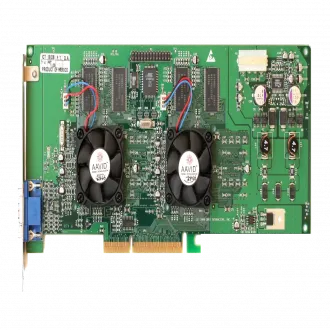Voodoo 5 5000
The unreleased Voodoo 5 5000 was to be similar to the 5500 but with half of the RAM capacity (32 MB total).
Voodoo 5 5500
The Voodoo 5 5500 comes in three flavors: a universal AGP version (AGP 1/2x, prototypes were made with AGP4x-interface) with full sideband support, PCI, and the Mac Edition, which is only available for PCI, though could run in 66 MHz PCI slots. The Mac Edition has a DVI- and a VGA-A-out, the other versions just have one VGA-out.
In games, the Voodoo 5 5500 is able to outperform the NVIDIA GeForce 256 and ATI Rage 128 MAXX, but unfortunately Voodoo5 5500 was late to market and was up against the new GeForce 2 GTS and Radeon DDR, both of which easily outperformed the Voodoo 5.
Voodoo 5 6000
The Voodoo 5 6000 is the unreleased high-end product in the Voodoo5 line. It was to use 4x 166 MHz VSA-100 processors, each with its own 32 MB of 166 MHz SDRAM, resulting in the first 128 MB graphics card (consisting of sixteen 8 MB chips). Approximately 1000+ test cards were produced. Because the card used more power than the AGP specification allowed for, a special power supply called Voodoo Volts was to have been included with it. This would have been an external device that would connect to an AC outlet. Most of the prototype cards utilized a standard internal power supply drive power connector.
With regards to performance, little was known until enthusiasts were able to get pre-release hardware and run tests on it. The results showed that the Voodoo 5 6000 outperformed the GeForce 2 Ultra and Radeon 7500, which were the fastest iterations of the GeForce 2 and Radeon R100 lines, respectively. (It was rumored that GeForce 2 Ultra was intended to prevent 3dfx taking the lead with their Voodoo 5 6000.) In some cases, the 6000 was shown to compete well with the next-generation GeForce 3.
Unfortunately the production cost of the Voodoo5 6000 would have likely hampered its competitiveness from a profitability standpoint. Compared to the single-chip GeForce and Radeon cards, a Voodoo5 6000 is burdened with much redundancy and a complicated board. It was projected to have a $600 USD price tag, considerably higher than competing parts. Despite its high price point, the Voodoo5 6000 would not have offered next-generation DirectX 8.0 vertex and pixel shaders that would be found in the GeForce 3 (which was intended by Nvidia to replace the short-lived GeForce 2 Ultra as its flagship product) and Radeon 8500. The precarious financial situation of 3dfx was another factor contributing to the 6000's demise.
There were five revisions of the Voodoo 5 6000: (the numbers after the model state the build week: 10 for week 10, 00 for year 2000).
